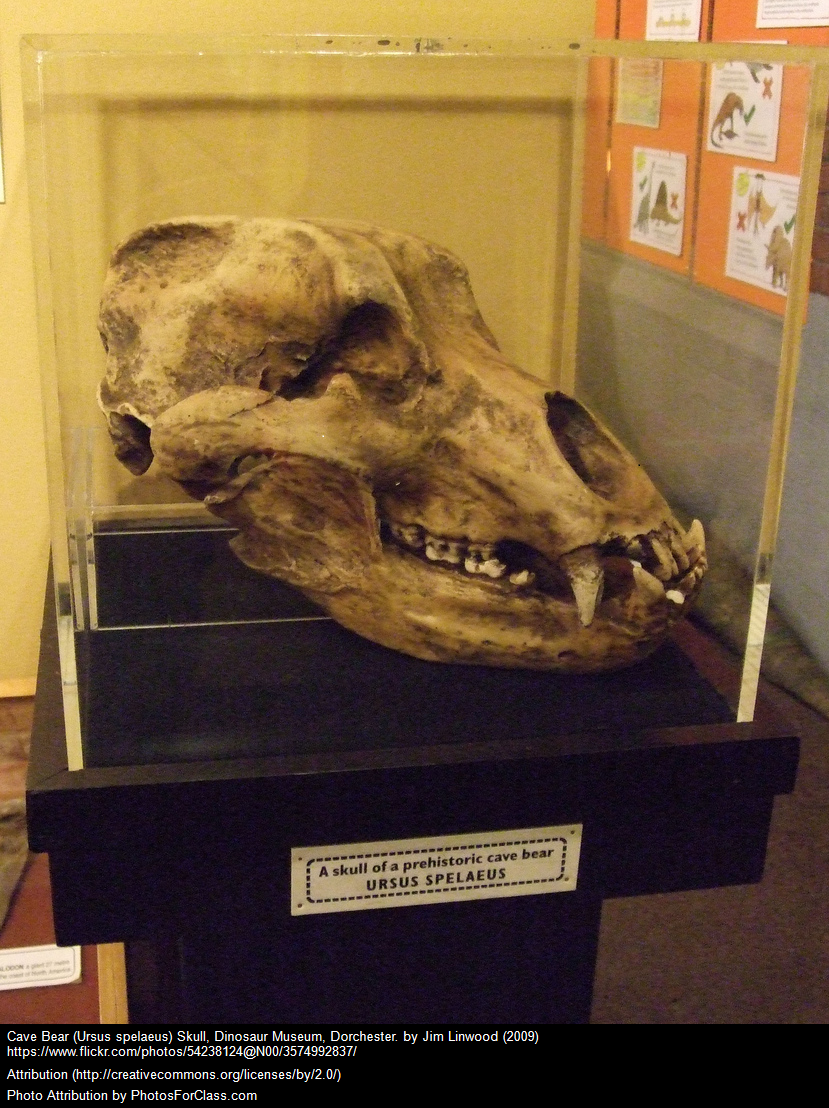Last week the story of a hybrid hominin was in the news: the discovery that remains found in Denisova Cave were those of a 13-year-old girl whose parents were a female Neandertal and a Denisovan male. This was exciting stuff: we already know, from genomic analysis, that interspecies matings involving Neanderthals, Denisovans, and H.sapiens happened – but to actually find the remains of someone whose existence was the result of such a mating is quite something!
Now, interspecies hybridisation isn’t all that rare – after all, the ‘biological species concept‘ is just that, a concept that helps us make sense of biological diversity. Of course, species themselves don’t care about such details: there are even occasions when lions & tigers may interbreed, for example, and now a new paper by Barlow et al. shows that in the past the same has been true for bearsA: specifically, European cave bears (Ursus spelaeus) and brown bears (Ursus arctos). (Breeding between polar bears (U.maritimus) & brown bears has already been documented.)

Cave bears were members of the Pleistocene megafauna, with big males weighing in at around 1,000 kg, twice the average size of today’s polar bears. Their range was fairly restricted, from Spain to Russia’s Ural Mountains, while the related brown bear was found throughout Europe and northern Asia; the two species were sympatric, and at times may have been found in the same habitat (a situation known as syntopy). Cave bears went extinct about 25,000 years ago, after a long decline, and Barlow et al. state that interactions with humans quite probably contributed to their final disappearance. Given the evidence for sympatry of cave and brown bears in the Pleistocene, the researchers decided to see whether these species might provide evidence for “a genetic contribution of ecologically and morphologically divergent Pleistocene megafauna to living mammal populations”.
To test this idea, the team were able to obtain nuclear aDNA from the remains of 4 cave bears, three from Europe (two from Austria) & the fourth from Armenia, in the Caucasus. These individuals lived from 34,000 to 71,000 years ago. They also obtained aDNA from a 41,000-years-old brown bear, also from Austria. These samples were sequenced and compared with DNA sequences from modern brown bears from populations covering the geographic range of U.arctos, and with previously-published datasets for a range of other living bears and the giant panda.
What did they find?
Well, first up, while there are a number of sub-groups within Ursus spelaeus, the sequence comparisons showed that cave bears are indeed monophyletic, and are a sister taxon to brown and polar bears. They also showed that the cave bear from what is now Armenia was genetically distinct from those found in Europe.
The team then looked for evidence of genetic admixture between cave and brown bears. The researchers found that modern brown bear populations show a certain amount of variation in the proportion of cave bear alleles found in their genomes, from up to 1% in Russian and American brown bears to at least 1.8% in bears from Georgia; that is, there is clear evidence of gene flow between the two species back in the Pleistocene, with cave bear alleles persisting into the present day. Next they used some specialised statistical tools to see if they could determine which way this gene flow was operating (from cave to brown bears? or brown to cave bears? or in both directions?), and found “clear and consistent evidence of gene flow from cave bears into brown bears”, and some evidence of earlier flow in the other direction.
What effect might this inter-ursid hankypanky have had on the bears’ evolution? Barlow et al. comment that it’s hard to tell. As cave bear alleles spread through the brown bear populations, due to hybrid individuals breeding with brown bears (something known as introgression), it’s possible that they could have provided an adaptive advantage in some conditions. Or they might have been selected against. The team comment that part of the answer might come from studying the modern, widespread, brown bear populations, which have received “alleles from two ecologically and morphologically divergent lineages in their recent evolutionary history: cave bears and polar bears. [They] thus represent an excellent opportunity to study the biological implications of admixture in a dynamic multispecies system…” In other words, we don’t actually know the answer at this point, but future research and additional information about bear species’ genetics should help us get there..
Terry Pratchett once said that someone isn’t truly dead & gone until the ripples they’ve made in the world finally disappear. Barlow and his colleagues suggest that we may be able to say the same for species that have long since ceased to walk the planet:
Using this method, we have shown that a fraction of the cave bear gene pool survives in the genomes of living brown bears, mirroring the Neanderthal ancestry found in non-African humans, but at much deeper phylogenetic divergence … At the genetic level, species may survive and participate in the theatre of evolution for tens of thousands of years after their disappearance from the fossil record.
I quite like that ideaB.
A yes, I know it’s a laboured reference to one of my favourite childhood films, but I couldn’t resist 🙂
B but I would hate to see it used to argue that therefore ‘extinction doesn’t really matter’.
A.Barlow, J.A.Cahill, S.Hartmann, C.Theunert, G.Xenikudakis, G.G.Fortes, J.L.A.Paijmans, G.Rabeder, C.Frischauf, A.Grandal-d’Anglade, A.Garcia-Vazquez, M.Murtskjvaladze, R.Saarma, P.Anijalg, T.Skrbinsek, G.Bertorelle, B.Gasparian, G.Bar-Oz, R.Pinhasi, M.Slatkin, L.Dalen, B.Shapiro & M.Hofreiter (2018) Partial genomic survival of cave bears in living brown bears. Nature Ecology & Evolution doi.org/10.1038/s41559-018-0654-8